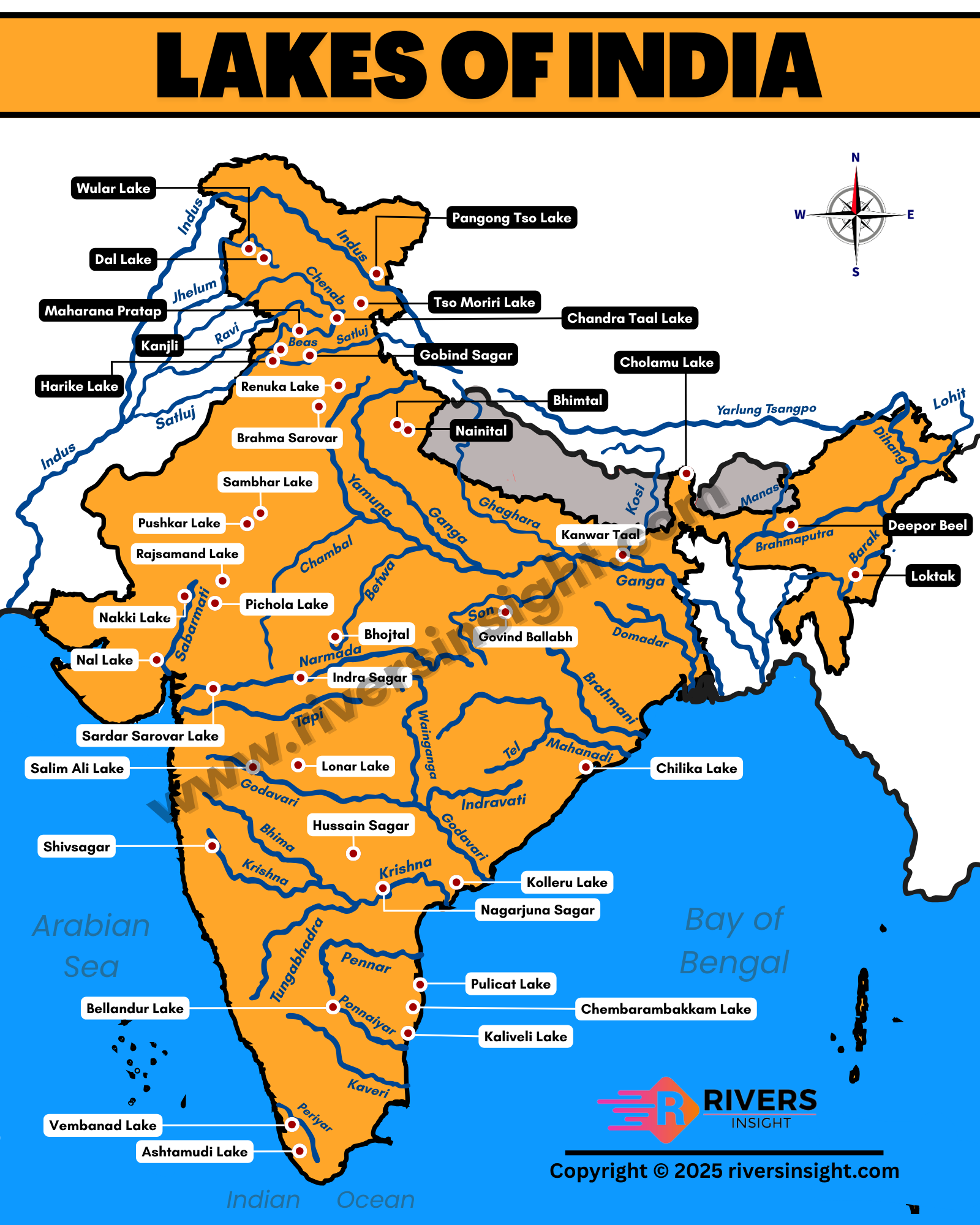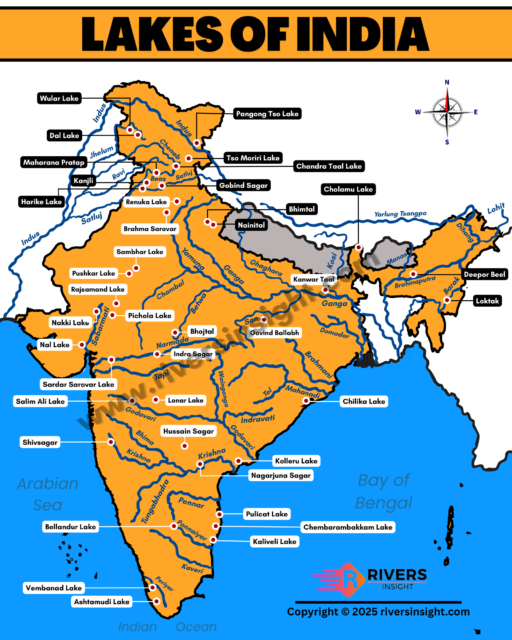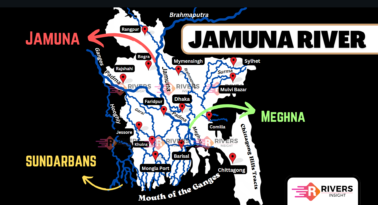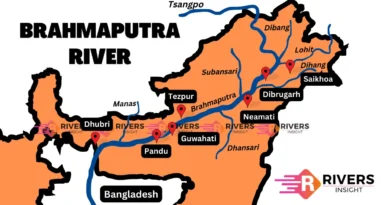Lakes in India: Map, Largest Artificial, Salt & Freshwater
A lake is a large water body that is surrounded by land. It can contain either freshwater or saltwater. Some lakes form naturally through glaciers, landslides, or tectonic activity. Others are created by humans for storing water or supporting daily needs.
In India, there are many lakes found across different regions. Each one serves a purpose and holds its own importance. For example, Vembanad Lake in Kerala is the largest lake in India while Tso Lhamo in Sikkim is known as one of the highest lakes in the country.
In this article, we will explore all the major lakes in India. You will learn about the different types of lakes such as natural lakes, artificial lakes, freshwater lakes and saltwater lakes. Along with that, we will look at the largest, deepest and highest lakes in the country. Further, we will also include a state-wise list and a map of important lakes to make it easy to understand.
Table of Contents
Types of Lakes in India
Lakes in India are formed in different ways and have various types of water. Below is a simple classification of the main types of lakes, along with real examples and key facts:
1. Freshwater Lakes
These lakes have fresh water, mostly from rainfall, river inflow, or melting snow. They are essential for drinking water, irrigation, and fishery.
- Wular Lake – fed by the Jhelum River (largest freshwater lake in India)
- Dal Lake – in Srinagar, supports tourism
- Kolleru Lake – linked to the Godavari and Krishna rivers
2. Saltwater (Saline) Lakes
These lakes contain salty or brackish water, mostly formed in closed basins or near the coast. Many of them support migratory birds and salt farming.
- Sambhar Lake – Rajasthan (largest inland saltwater lake in India)
- Pulicat Lake – Andhra Pradesh and Tamil Nadu border (second largest brackish water lake)
- Chilika Lake – Odisha (largest brackish water lake in India)
3. Tectonic Lakes
Formed by movements in the Earth’s crust, such as faulting or folding. These are often deep and natural basins.
- Wular Lake – formed due to tectonic activity
- Loktak Lake – in Manipur, influenced by tectonic shifts
4. Glacial Lakes
Created by melting glaciers, these lakes are mostly found in Himalayan regions. They are cold, clear, and often at high altitudes.
- Tso Moriri Lake – Ladakh (one of the highest lakes in India)
- Gurudongmar Lake – Sikkim (among the highest freshwater lakes in the world)
5. Crater (Volcanic) Lakes
These lakes are formed in volcanic or meteor craters, filled with rainwater or groundwater. They are rare and often circular.
- Lonar Lake – Maharashtra (only saltwater crater lake in India, formed by meteor impact)
6. Artificial (Man-made) Lakes
These are created by human intervention, often by building dams or reservoirs for water supply, irrigation, or hydroelectricity.
- Gobind Sagar Lake – Himachal Pradesh (formed by Bhakra Dam on the Sutlej River)
- Hussain Sagar Lake – Hyderabad (built in the 16th century)
7. Oxbow Lakes
Oxbow lakes are curved lakes formed when a river meander is cut off from the main channel. These are common in floodplains of large rivers.
- Found mostly in northern and eastern India, near rivers like the Ganga, Kosi, and Brahmaputra
- Often seen in states like Bihar, Assam, and Uttar Pradesh
- Important for local fisheries and seasonal water storage
Map of Lakes in India

10 Major Lakes in India
1. Wular Lake
- Located in Jammu and Kashmir
- One of the largest freshwater lakes in India
- Formed by tectonic movements
- Controls the flow of the Jhelum River, which passes through the lake
- Important bird habitat
2. Chilika Lake
- Located in Odisha
- Largest brackish water lake in India
- Second largest coastal lagoon in the world
- Fed by 52 rivers including including Daya and Bhargavi
- Home to many migratory birds
3. Sambhar Lake
- Located in Rajasthan
- Largest saltwater lake in India
- Famous for salt production
- Fed by the Sambhar River and small streams
- Habitat for flamingos and migratory birds
4. Vembanad Lake
- Located in Kerala
- Longest freshwater lake in India
- Connected to several rivers like Meenachil and Achankovil
- Known for scenic backwaters and houseboat cruises
- Supports unique plants and animals
5. Loktak Lake
- Located in Manipur
- Has floating islands called ‘phumdis’
- Fed by the Manipur River and other smaller streams
- Shelter for endangered Sangai deer
- Important for local fishermen
6. Kolleru Lake
- Located in Andhra Pradesh
- One of the largest freshwater lakes
- Fed by the Godavari and Krishna river systems
- Designated wildlife sanctuary
- Attracts migratory birds in winter
7. Lonar Lake
- Located in Maharashtra
- Volcanic crater lake over 50,000 years old
- Contains salty water
- Unique geological formation
8. Tso Moriri Lake
- Located in Ladakh
- High-altitude glacial lake
- Fed by glacial streams, part of the Indus River basin
- Clear blue water
- Surrounded by snow-capped mountains
9. Pulicat Lake
- Located on the border of Andhra Pradesh and Tamil Nadu
- Second largest brackish water lake in India
- Fed by the Arani and Kalangi rivers
- Important for fisheries and birdlife
10. Dal Lake
- Located in Srinagar, Jammu and Kashmir
- Famous freshwater lake in the Kashmir Valley
- Fed by the Jhelum River and small streams
- Known for its floating gardens and houseboats
Highest and Deepest Lakes in India
- Highest Lake in India: Tso Moriri Lake in Ladakh is the highest large lake, situated at an altitude of about 4,522 meters (14,836 feet). It is a cold desert lake surrounded by mountains and is a protected area known for its unique wildlife.
- Highest Freshwater Lake: Pangong Tso (also in Ladakh) is a saltwater lake but famous for its breathtaking views and high elevation, around 4,350 meters (14,270 feet).
- Deepest Lake in India: Chilka Lake in Odisha is one of the deepest and largest brackish water lagoons in India. It has an average depth of around 1.5 meters but can reach up to 4 meters in some parts.
State-wise List of Lakes in India
| State/UT | Important Lakes |
|---|---|
| Jammu & Kashmir | Wular Lake, Dal Lake, Mansar Lake |
| Ladakh | Pangong Tso, Tso Moriri, Tso Kar |
| Himachal Pradesh | Renuka Lake, Chandra Tal, Gobind Sagar Lake |
| Punjab | Harike Wetland |
| Uttarakhand | Naini Lake, Bhimtal Lake, Sattal, Tehri Lake |
| Rajasthan | Sambhar Lake, Pushkar Lake, Ana Sagar Lake, Nakki Lake |
| Uttar Pradesh | Keetham Lake, Belasagar Lake |
| Bihar | Kanwar Lake (Oxbow), Ganga Sagar |
| West Bengal | East Calcutta Wetlands, Rasikbil Lake |
| Odisha | Chilika Lake, Ansupa Lake |
| Chhattisgarh | Khutaghat Lake, Tandula Lake |
| Jharkhand | Ranchi Lake, Dimna Lake |
| Madhya Pradesh | Upper Lake (Bhopal), Lower Lake (Bhopal) |
| Gujarat | Nal Sarovar, Thol Lake |
| Maharashtra | Lonar Crater Lake, Shivsagar Lake, Rankala Lake |
| Goa | Carambolim Lake, Mayem Lake |
| Karnataka | Ulsoor Lake, Bellandur Lake, Sankey Tank |
| Kerala | Vembanad Lake, Ashtamudi Lake, Sasthamkotta Lake |
| Tamil Nadu | Pulicat Lake, Veeranam Lake |
| Andhra Pradesh | Kolleru Lake, Pulicat Lake |
| Telangana | Hussain Sagar, Osman Sagar, Himayat Sagar |
| Assam | Dipor Bil, Chandubi Lake |
| Manipur | Loktak Lake |
| Mizoram | Palak Dil |
| Tripura | Rudrasagar Lake |
| Nagaland | Shilloi Lake |
| Sikkim | Gurudongmar Lake, Tsomgo Lake |
| Arunachal Pradesh | Sangestar Tso (Madhuri Lake), Pankang Teng Tso |
List of Artificial Lakes
Here are some major artificial lakes in India:
- Hussain Sagar (Telangana): Built in 1563, this lake connects Hyderabad and Secunderabad.
- Upper Lake (Bhopal, Madhya Pradesh): Also known as Bhojtal, created in the 11th century, it is one of the oldest artificial lakes in India.
- Saras Sagar Lake (Uttar Pradesh): A man-made lake used mainly for irrigation.
- Tehri Lake (Uttarakhand): Created by the Tehri Dam on the Bhagirathi River, used for hydroelectric power and water supply.
- Shivaji Sagar Lake (Maharashtra): Formed by the damming of the Krishna River.
- Nagarjuna Sagar Lake (Telangana and Andhra Pradesh): One of the largest artificial reservoirs in Asia.
- Rihand Dam Reservoir (Uttar Pradesh): Built on the Rihand River, mainly for power generation.
- Indira Sagar Lake (Madhya Pradesh): Formed on the Narmada River.




